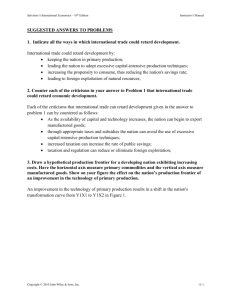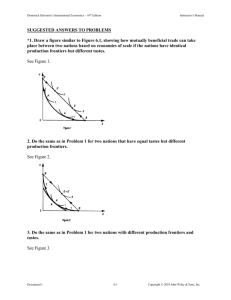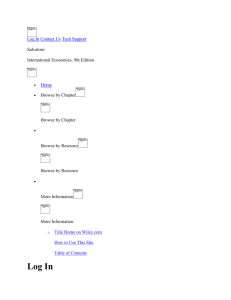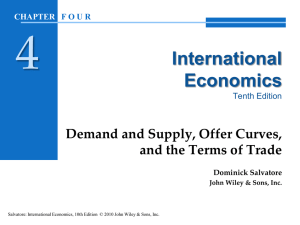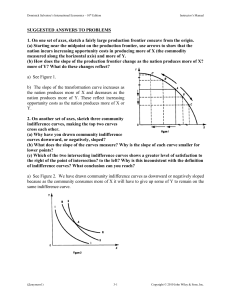Chapter 7 Book Answers
advertisement
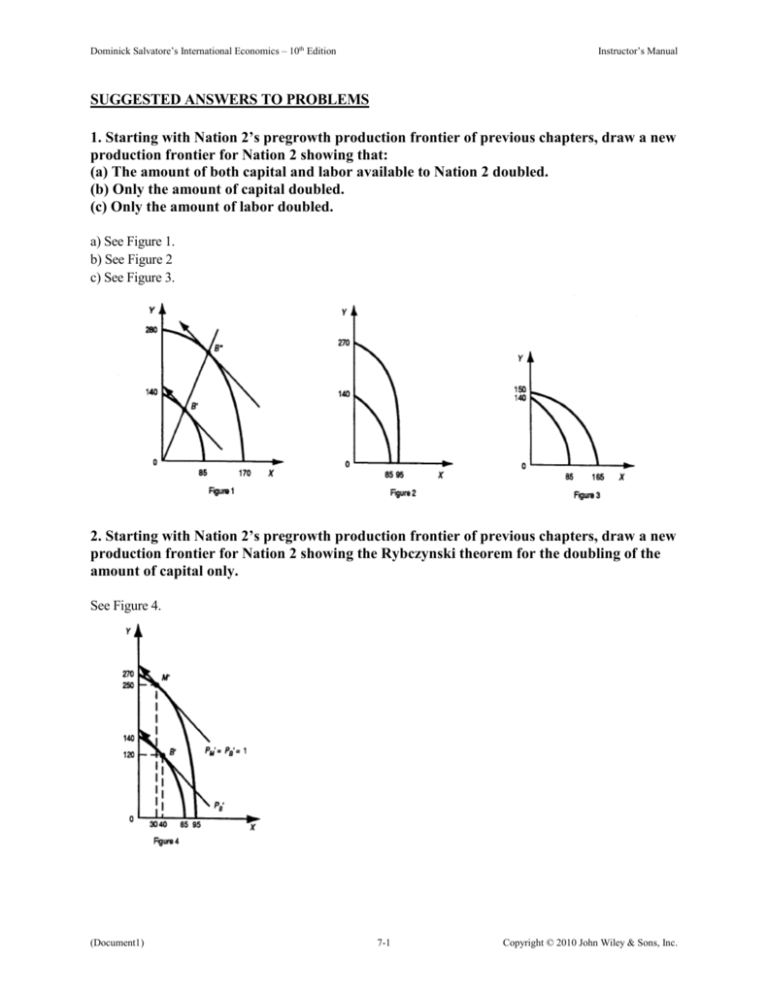
Dominick Salvatore’s International Economics – 10th Edition Instructor’s Manual SUGGESTED ANSWERS TO PROBLEMS 1. Starting with Nation 2’s pregrowth production frontier of previous chapters, draw a new production frontier for Nation 2 showing that: (a) The amount of both capital and labor available to Nation 2 doubled. (b) Only the amount of capital doubled. (c) Only the amount of labor doubled. a) See Figure 1. b) See Figure 2 c) See Figure 3. 2. Starting with Nation 2’s pregrowth production frontier of previous chapters, draw a new production frontier for Nation 2 showing the Rybczynski theorem for the doubling of the amount of capital only. See Figure 4. (Document1) 7-1 Copyright © 2010 John Wiley & Sons, Inc. Dominick Salvatore’s International Economics – 10th Edition Instructor’s Manual 3. Starting with Nation 2’s pregrowth production frontier, draw a production frontier for Nation 2 showing neutral technical progress that doubles the productivity of labor and capital in the production of: (a) Both commodity X and commodity Y. (b) Commodity X only. (c) Commodity Y only. a) See Figure 5. b) See Figure 6. c) See Figure 7. (Document1) 7-2 Copyright © 2010 John Wiley & Sons, Inc. Dominick Salvatore’s International Economics – 10th Edition Instructor’s Manual 4. Compare the graphs in Problem 3 with those in Problems 1 and 2. Compare Figure 5 to Figure 1. Compare Figure 6 to Figure 3. Note that the two production frontiers have the same vertical or Y intercept in Figure 6 but a different vertical or Y intercept in Figure 3. Compare Figure 7 to Figure 2. Note that the two production frontiers have the same horizontal or X intercept in Figure 7 but a different horizontal or X intercept in Figure 2. *5. Draw for Nation 2 a figure analogous to the top panel of Figure 7.4 under the following assumptions: (a) Only the amount of capital doubles in Nation 2. (b) The free trade equilibrium-relative commodity price is PX/PY = 1. (c) Nation 2 is too small to affect the relative commodity prices at which it trades before and after growth. (d) Nation 2 exports 150Y after growth. See Figure 8. *6. Draw for Nation 2 a figure analogous to the bottom panel of Figure 7.4 under the same assumptions as in Problem 5. See Figure 9. (Document1) 7-3 Copyright © 2010 John Wiley & Sons, Inc. Dominick Salvatore’s International Economics – 10th Edition Instructor’s Manual 7. Draw for Nation 2 a figure analogous to the top panel of Figure 7.5 under the following assumptions: (a) Nation 2 is now large enough to affect the relative commodity prices at which it trades. (b) The terms of trade of Nation 2 deteriorate from PY /PX = 1 with free trade before growth to PY /PX = 1/2 with growth and free trade. (c) Nation 2 exports 140Y with growth and free trade. See Figure 10. 8. Draw for Nation 2 a figure analogous to the bottom panel of Figure 7.5 under the same assumptions as in Problem 7. See Figure 11. (Document1) 7-4 Copyright © 2010 John Wiley & Sons, Inc. Dominick Salvatore’s International Economics – 10th Edition Instructor’s Manual *9. Draw a figure analogous to Figure 7.6 showing immiserizing growth for Nation 2 when the productivity of capital and labor doubled only in the production of commodity Y in Nation 2. See Figure 12. 10. Draw a figure similar to Figure 7.6 but showing immiserizing growth for an increase in the population and labor force of a nation. See Figure 13. (Document1) 7-5 Copyright © 2010 John Wiley & Sons, Inc. Dominick Salvatore’s International Economics – 10th Edition Instructor’s Manual 11. Draw for Nation 2 a figure analogous to the top panel of Figure 7.7 under the following assumptions: (a) Only the amount of labor doubles in Nation 2. (b) The terms of trade of Nation 2 improve from PY /PX = 1 with free trade before growth to PY /PX = 2 with growth and free trade. (c) Nation 2 exports 20Y with growth and free trade. See Figure 14. 12. Draw for Nation 2 a figure analogous to the bottom panel of Figure 7.7 under the same assumptions as in Problem 11. See Figure 15. (Document1) 7-6 Copyright © 2010 John Wiley & Sons, Inc. Dominick Salvatore’s International Economics – 10th Edition Instructor’s Manual 13. The data in Table 7.3 indicate that the United States has the smallest increase in output per worker, no improvements in efficiency, and a small improvement in technology in relation to other countries in the table. This seems to contradict the information in Table 6.3. How can this seeming contradiction be resolved? The United States has become the most competitive economy in the world since the early 1990s while the data in Table 7.3 refers to the 1965-1990 period. The data in Table 7.4 seem to indicate that China had a comparative advantage in capital-intensive commodities and a comparative disadvantage in unskilled-labor intensive commodities in 1973. This was very likely due to the many trade restrictions and subsidies, which distorted the comparative advantage of China. Its true comparative advantage became evident by 1993 after China had started to liberalize its economy. * = Answer provided at www.wiley.com/college/salvatore. SUGGESTED ANSWERS TO PROBLEMS IN APPENDIX A7.1 Problem (a) Starting from pretrade, or autarky, equilibrium point A* in Nation 2, prove graphically the Rybczynski theorem for a doubling in the amount of K in Nation 2. (b) What restrictive assumption is required for production and consumption actually to occur at the new equilibrium point after the doubling of K in Nation 2? (c) How are relative commodity prices likely to change as a result of growth only? A result of both growth and free trade? a) See Figure 16. b) For production and consumption to actually occur at the new equilibrium point after the doubling of K in Nation 2, we must assume either than commodity X is inferior or that Nation 2 is too small to affect the relative commodity prices at which it trades. c) Px/Py must rise (i.e., Py/Px must fall) as a result of growth only. Px/Py will fall even more with trade. A7.2 Problem What happens if the supply of capital increases in Nation 1 in the production of commodity Y only? If the supply of capital increases in Nation 1 in the production of commodity Y only, the VMPLy curve shifts up, and w rises in both industries. Some labor shifts to the production of Y, the output of Y rises and the output of X falls, r falls, and Px/Py is likely to rise. (Document1) 7-7 Copyright © 2010 John Wiley & Sons, Inc. Dominick Salvatore’s International Economics – 10th Edition Instructor’s Manual A7.3 Problem Using the tools of analysis developed in this chapter, comment in detail on the following statement: Capital investments tend to increase real wages while technical progress, depending on its type, may increase or reduce real wages. Capital investments tend to increase real wages because they raise the K/L ratio and the productivity of labor. Technical progress tends to increase K/L and real wages if it is L-saving and to reduce K/L and real wages if it is K-saving. (Document1) 7-8 Copyright © 2010 John Wiley & Sons, Inc.
